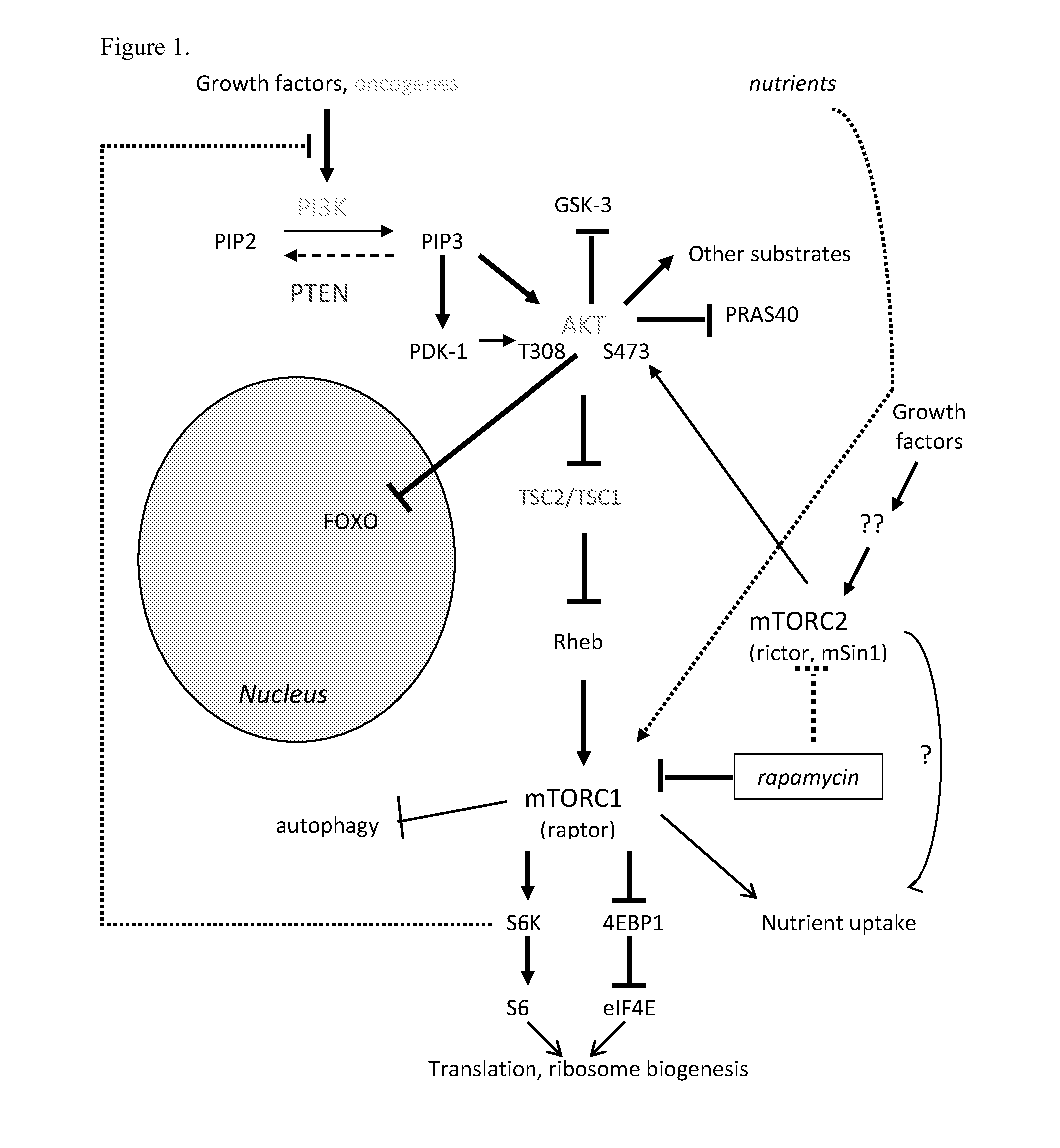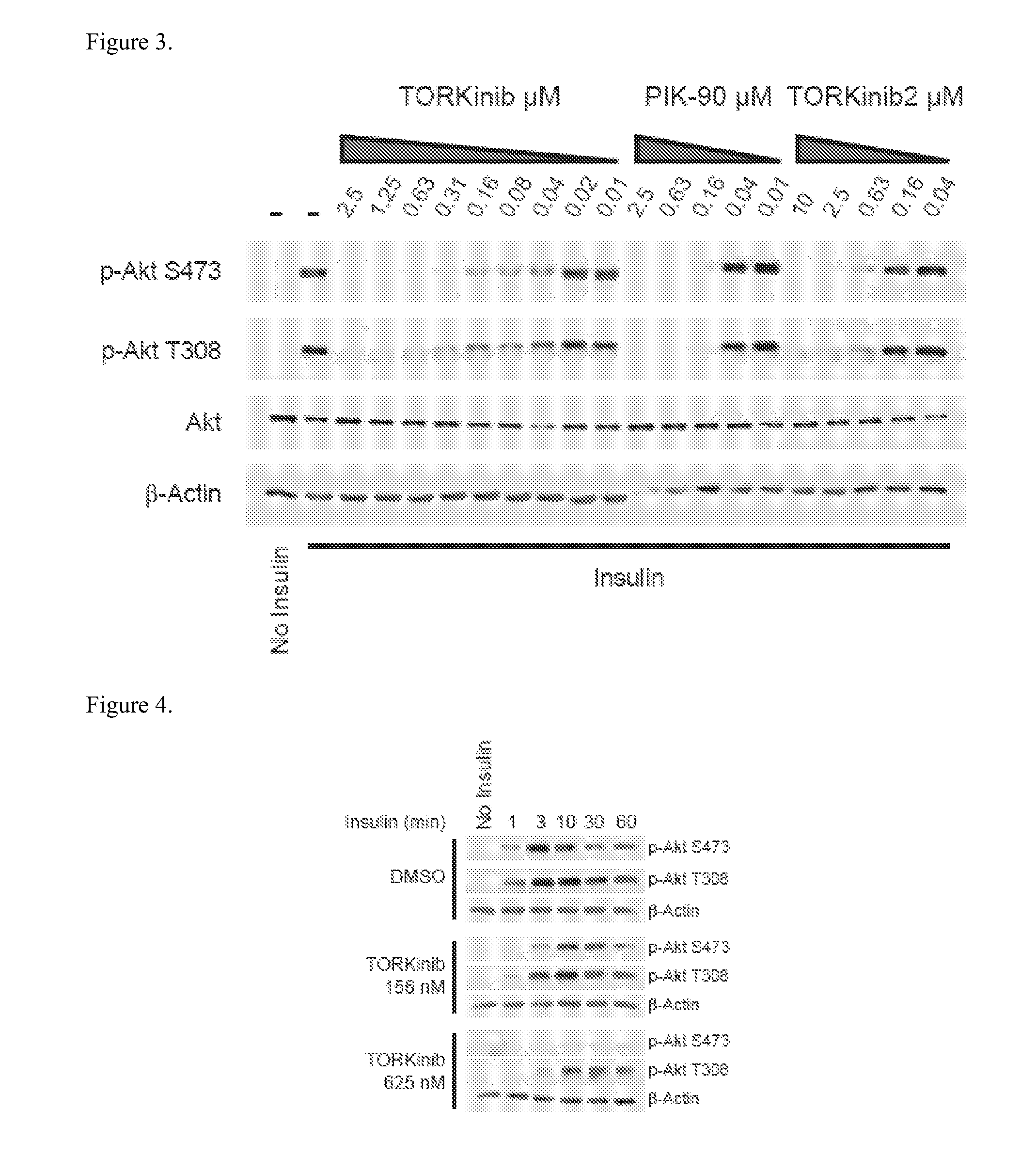MTOR Modulators and Uses Thereof
a technology of mtor and modulator, which is applied in the direction of chemical treatment enzyme inactivation, drug composition, cardiovascular disorder, etc., can solve problems such as apoptosis or cell cycle arrest, and achieve the effect of enhancing the effect of said treatmen
- Summary
- Abstract
- Description
- Claims
- Application Information
AI Technical Summary
Benefits of technology
Method used
Image
Examples
example 1
[0228]Purified kinase domains (e.g. mTor, P110α, P110β, P110γ, P110δ, PI4Kβ, DNA-PK, PKCα, PKCβ1, PKCβII, RET, and JAK2) were incubated with inhibitors at 2- or 4-fold dilutions over a concentration range of 50-0.001 μM or with vehicle (0.1% DMSO) in the presence of 10 μM ATP, 2.5 μCi of γ-32P-ATP and substrate. Reactions were terminated by spotting onto nitrocellulose or phosphocellulose membranes, depending on the substrate; this membrane was then washed 5-6 times to remove unbound radioactivity and dried. Transferred radioactivity was quantitated by phosphorimaging and IC50 values were calculated by fitting the data to a sigmoidal dose-response using Prism software.
[0229]The results as shown in FIG. 2 demonstrate that TORKinib is a potent and specific inhibitor of mTor with an IC50 of about 8 nM. TORKinib was also relatively inactive against PKCβ, RET, and JAK2 (V617F), but inhibited PKCα with an IC50 of about 50 nM. TORKinib2 likewise is an extremely poten...
example 2
Effect of mTor Inhibitors on Kinase Substrate Phosphorylation
[0230]L6 myoblasts were grown typically grown in DMEM supplemented with about 10% FBS, glutamine and penicillin / streptomycin. Confluent L6 myoblasts were differentiated into myotubes by culturing them for approximately 5 days in media containing about 2% FBS. L6 myotubes were maintained in media containing approximately 2% FBS until use.
[0231]In order to compare the effect of TORKinibs and PIK-90 on Akt phosphorylation, L6 myotubes were serum starved overnight and incubated with inhibitors or about 0.1% DMSO for approximately 30 minutes prior to stimulation with insulin (e.g. 100 nM) for about 10 minutes. Cells were lysed by scraping into ice cold lysis buffer (generally: 300 mM NaCl, 50 mM Tris pH 7.5, 5 mM EDTA, 1% Triton X-100, 0.02% NaN3, 20 nM microcystin, Sigma phosphatase inhibitor cocktails 1 and 2, Roche protease inhibitor cocktail and 2 mM PMSF). After contacting cells with lysis buffer, the solution was briefly ...
example 3
Kinetics of Kinase Substrate Phosphorylation
[0233]L6 myotubes were serum starved overnight and incubated with TORKinib or 0.1% DMSO for about 30 minutes prior to stimulation with insulin (e.g. 100 nM) for about 1, 3, 10, and 60 minutes. Cells were lysed by scraping into ice cold lysis buffer (generally 300 mM NaCl, 50 mM Tris pH 7.5, 5 mM EDTA, 1% Triton X-100, 0.02% NaN3, 20 nM microcystin, Sigma phosphatase inhibitor cocktails 1 and 2, Roche protease inhibitor cocktail and 2 mM PMSF). After contacting cells with lysis buffer, the solution was briefly sonicated. Lysates were cleared by centrifugation, resolved by SDS-PAGE, transferred to nitrocellulose and immunoblotted using antibodies to phospho-Akt S473, phospho-Akt T308, and actin. The results as shown in FIG. 4 demonstrate that differential sensitivity of S473 and T308 to inhibition of phosphorylation by TORKinibs may not reflect differing kinetics of phosphorylation.
PUM
 Login to View More
Login to View More Abstract
Description
Claims
Application Information
 Login to View More
Login to View More - R&D
- Intellectual Property
- Life Sciences
- Materials
- Tech Scout
- Unparalleled Data Quality
- Higher Quality Content
- 60% Fewer Hallucinations
Browse by: Latest US Patents, China's latest patents, Technical Efficacy Thesaurus, Application Domain, Technology Topic, Popular Technical Reports.
© 2025 PatSnap. All rights reserved.Legal|Privacy policy|Modern Slavery Act Transparency Statement|Sitemap|About US| Contact US: help@patsnap.com



